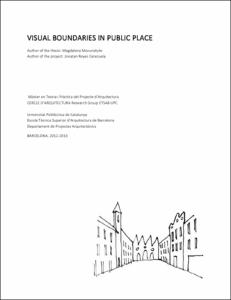Mostra el registre d'ítem simple
Visual boundaries in public place
| dc.contributor | Bru Bistuer, Eduard |
| dc.contributor.author | Mozuraityté, Magdalena |
| dc.contributor.other | Universitat Politècnica de Catalunya. Departament de Projectes Arquitectònics |
| dc.coverage.spatial | east=31.23526579999998; north=30.0445393; name=El Caire, Governació del Caire, Egipte |
| dc.coverage.spatial | east=13.413214700000026; north=52.5219184; name=U Alexanderplatz (Berlin) [Tram], 10178 Berlin, Alemanya |
| dc.coverage.spatial | east=2.186858654022217; north=41.40340260589794; name=Pl. Glòries Catalanes, s/n, 08018 Barcelona, Espanya |
| dc.date.accessioned | 2014-02-04T15:16:55Z |
| dc.date.available | 2014-02-04T15:16:55Z |
| dc.date.issued | 2013 |
| dc.identifier.uri | http://hdl.handle.net/2099.1/20660 |
| dc.description | A la portada: "Author of the project: Jonatan Reyes Cerezuela" |
| dc.description.abstract | Geometrically simplified urban spaces could be understood as compositions of horizontal and vertical surfaces, which create volumes of vacancy. Obviously vertical limiting elements is important for space, influencing its shape and character, but nowadays open plan is more valued, so does contemporary urban square can function well without clearly defined boundary? In this thesis I analyze certain problematic public squares and approached the answer how much the enclosure is important for well functioning urban place. These are main questions that I tried to answer writing my thesis: - Does strong architectural frame improve space qualities? - How much important are boundaries to the space and what is relation is between space and surrounding architecture? - Do we really need a frame to understand the content? My analysis material was freely chosen projects of architecture students that had task to reform three different, but in many aspects similar squares: Glories in Barcelona, Alexanderplatz in Berlin and Tahrir in Cairo. There were very distinct propositions among students’ works, but I chose a project of Jonatan Reyes Cerezuela, because the way he looked to the issues of these squares and the focal points matched with my general idea of the thesis. Major part of students noticed that one of the issues of GAT (Glories, Alexanderplatz and Tahrir) is poorly defined space, which lacks human scale and most of them attempted to change that proposing element which draw clearer line of the boundary. Jonatan introduced stronger limits in squares, but respectively adopted different solutions to each of them. While discussing the project, be both benefited from our conversations (at least I certainly did) finding out different points of view of the same subject. Analyzing issues and possible solution for GAT I learned that contemporary public space needs defined visual character, which majorly bases on architectural elements participating in space. Although visual, not physical enclose is preferred and spatial transparency, clear urban connections are desired while creating well functioning public place. I believe it’s important because I see public space as outdoor room, which should be understood and taken as place orientated to humans. Are boundaries of such places important? I believe that yes, they are. Is not that we always need to outline all existent objects to recognize them, as in animated cartoons, but boundaries definitely help do that and they can take various forms. |
| dc.language.iso | eng |
| dc.publisher | Universitat Politècnica de Catalunya |
| dc.rights | Attribution-NonCommercial-ShareAlike 3.0 Spain |
| dc.rights.uri | http://creativecommons.org/licenses/by-nc-sa/3.0/es/ |
| dc.subject | Àrees temàtiques de la UPC::Urbanisme |
| dc.subject.lcsh | Plazas -- Germany -- Berlin |
| dc.subject.lcsh | Plazas -- Spain -- Barcelona |
| dc.subject.lcsh | Plazas -- Egypt -- Cairo |
| dc.title | Visual boundaries in public place |
| dc.type | Master thesis |
| dc.subject.lemac | Places -- Alemanya -- Berlín |
| dc.subject.lemac | Places -- Catalunya -- Barcelona |
| dc.subject.lemac | Places -- Egipte -- Caire |
| dc.rights.access | Open Access |
| dc.audience.educationlevel | Màster |
| dc.audience.mediator | Escola Tècnica Superior d'Arquitectura de Barcelona |
| dc.audience.degree | MÀSTER UNIVERSITARI EN TEORIA I PRÀCTICA DEL PROJECTE D'ARQUITECTURA (Pla 2009) |


